A day dedicated to gelato. Or rather to redefining the universe of cones and cups, which for too long was illtreated by featureless ice cream makers, focused only on chemicals and thickeners. This world has now taken the same road of redemption that pizza, for instance, experienced in the past decade. Gelato in connection with fine dining; gelato in search of new roads to take and different ways of being produced; gelato that, with this enthusiasm for improvements, often finds its contemporary identity by drawing from ancient knowledge and flavours. This was the leitmotiv of Identità di Gelato, first edition of the new congress created by Identità Golose in partnership with Motor Power Company. It took place last week, in the fascinating Rotonda a Mare in Senigallia. And indeed we start from the latter element – the location, that is – with the introduction given by Paolo Marchi, creator and curator of all of Identità, hence even of Identità di Gelato.
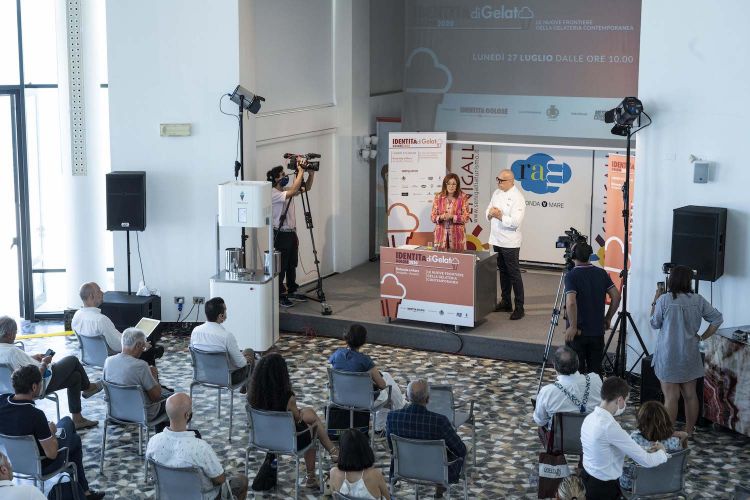
The room, with the necessary social distancing (but many were following online)
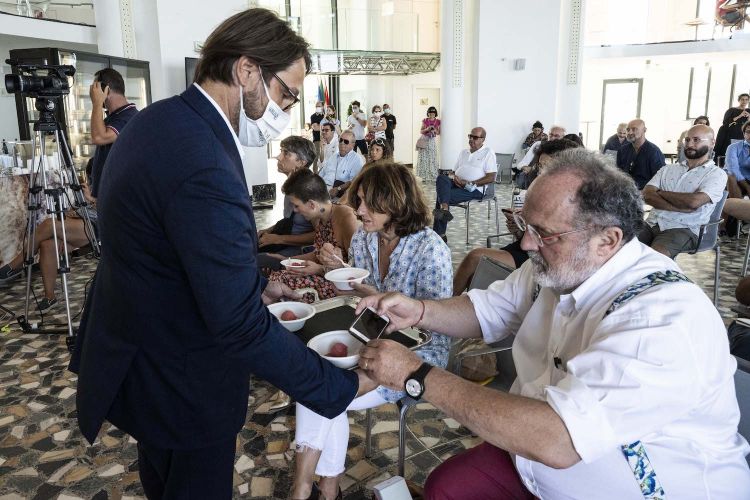
Andrea Polini offers an ice cream to Paolo Marchi
PAOLO MARCHI – «Being today in Senigallia is important for many reasons. First, let me take a step back to the Nineties. Moreno Cedroni and Mauro Uliassi were still at the beginning of their incredible careers, and Identità still didn’t exist. Over time, Senigallia experienced the incredible success of these two chefs, and we also started, and grew hugely. Mauro has ice cream in his DNA, his parents already ran an ice cream shop in the Sixties. Moreno is curious about everything; he’s been studying the different opportunities offered by ice creams for some time. I remember how on the 9th of June 2003 here in Senigallia, he surprised me with a sort of large ice cream cake: it was for my wedding reception, when I married Luisa».
So, of course Senigallia had to be the place where we’d host Identità di Gelato: «Now we’re here, in a place I hold very dear because as I said it sums up many important stages in my life. Let’s speak of gelato. In doing so, I often compare it to pizza: I used to eat only pizza with ham and anchovies, the only one I tolerated because in general the dough was horrible, it would leaven in my stomach. The same goes for gelato: only coffee and yogurt, it was the time when semifinished products prevailed. Now things are changing». And Identità, as always, will follow and support this change.
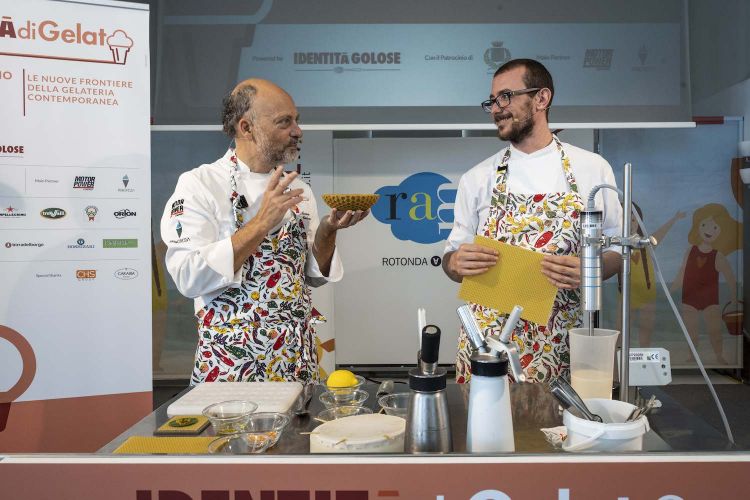
Moreno Cedroni and Luca Abbadir
– «I’m a chef, hence I make use of an advantage over ice cream makers when I deal with gelato: they have an absolute necessity, that of balancing the flavours. Of course I must know how to balance them, but then I can break that balance, because I’m not limited by cones and cups, my ice cream is part of a more complex dish in which each element can play in an aromatic contrast. In other words, I can let lose». And this is something that
Moreno Cedroni has done often in his career: sea gelatos, gelatos with fermented products, gelato cocktails... «I started to learn this art in 1988, and indeed
Paolo Marchi was among those who inspired me to do so». Now the focus of
Cedroni’s ideas and research is
Tunnel, the idea lab born one year ago and managed by his sous
Luca Abbadir. Here they develop culinary projects with the most advanced technologies. This is where the gelato-dish in two acts on which the chef from
Madonnina del Pescatorefocused his lesson was born. The protagonists: bees.
Abbadir explains: «We started to work on this in November, and now the result is in the menu». They started from a ceramic dish depicting a beehive; they made a 3d model with which they created a food mould in silicon. The result: a plate shaped like a beehive, entirely made with beeswax and disposable («Once used, you clean it then melt it to make a new one»).
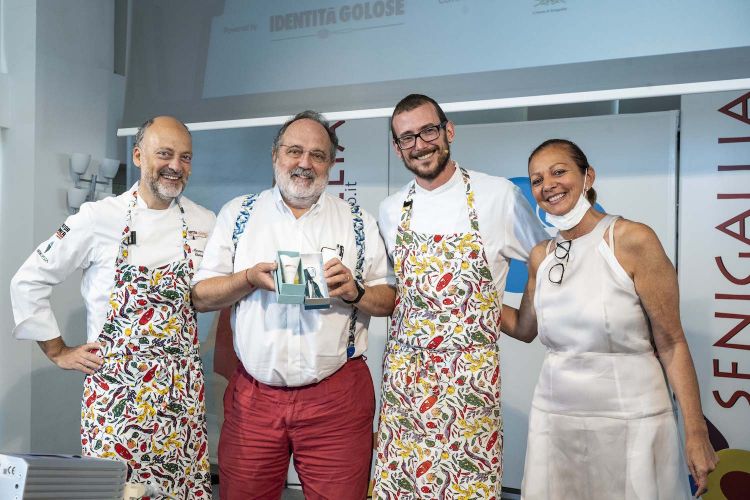
Cedroni and Abbadir with Paolo Marchi and Cinzia Benzi
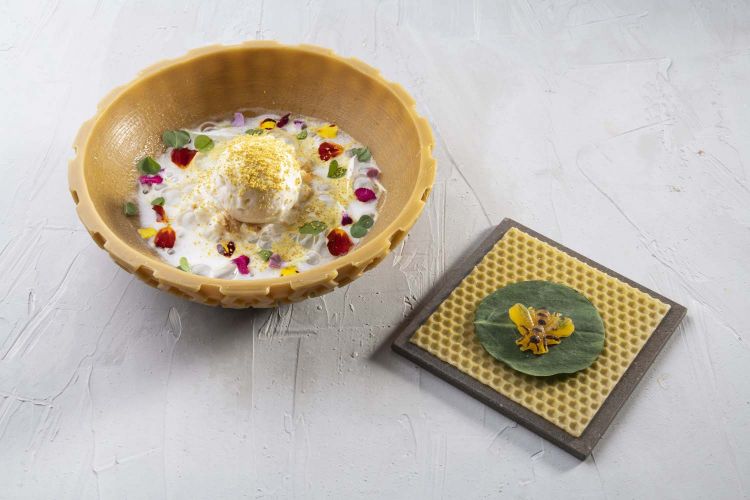
The meaning? «The enjoyment starts from the nose. The aroma of this dish is the first component you can perceive when tasting it». But what’s inside? The beeswax is not only in the plate but also on the plate, as an innovative thickener for the gelato, «it’s the first time this road is taken». Tunnelcame to help: «At first the wax formed lumps. We then melted it in the usual ice cream mix and then processed everything in an ultrasound machine for 20 minutes; this creates some microbubbles which, by exploding, fragment the structure of the mixture. This then goes in the Principessa ice cream machine and the result is a gelato that won’t melt and has a very special texture». Gelato with polyfloral honey, in this case; it’s served on a base of sponge cake, then a brunoise of carrots and Pink Lady apples, cream with elderberry syrup, lemon zest, sanded and salted hazelnuts, elderberry mousse, pollen, sorrel flowers and leaves. Bingo, here’s the Ape Reginaice-cream dish.
A tasty game introduced this tasting: fake edible bees made with honey in a mould (they’re made with jellified honey and agar agar, dried for 5 days at 40°S), coloured one by one and presented on a sorrel leaf «to use as if it were a taco shell», the delicious bee is wrapped in it and crunches under your teeth.
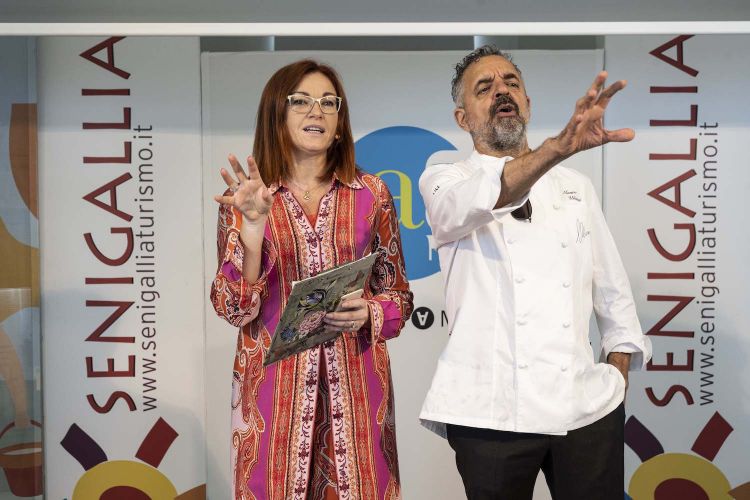
Mauro Uliassi and Eleonora Cozzella, who presented the entire event
MAURO ULIASSI – From Cedroni to Uliassi: time for bees, the research theme is the same. Three-starred Mauro says: «Gelato is part of my life. In the Sixties, my father who had a bar and ice cream shop. He was among the first to make artisanal gelato, with eight carapine. When I became a teacher at catering school, I attended some excellent courses on gelato, held by teachers like Donata Panciera, Cecchiniello, Luca Caviezel…». The result: «I have often used gelato, both in desserts and savoury dishes»: asparagus, onion, peppers, prawns, daiquiri, piña colada, «Lagavulin with a chocolate soufflé»…
This time, bees. Or rather honey. Or better still, fresh pollen (incredibly interesting, picked high in the mountains) and mead (an ancient fermented drink from honey, in this case from acacias, sunflowers and stachis) supplied by Giorgio Poeta, in Fabriano. They meet Buccarello from Caseificio Piandelmedico, a cheese made with buffalo milk, of medium ageing: this «must be balanced with milk, then you add the thickener and the sugars, and it all goes in the ice cream machine. We add gel and powdered camomile, honey, with some grated fresh pinecones, a mead meringue, flowers, powdered yogurt and pressed bramble and oak pollen», marvellous. Savoury, sweet, with notes of wax, «it’s not your usual ice cream».
Before that,
Uliassi presented a granita too: «I put the melon in a vacuum pack with the chartreuse, it starts the osmosis, we then freeze it and grate it with a
Microplane. It’s a perfect match, like melon and Porto, pear and grappa, pineapple and rum». To finish the dish «we build a series of other flavours»: a cream of lemon («Nice and sour, like the French
tarte au citron, to give a sapid contrast»), various herbs that recall the chartreuse, pieces of melon, toasted pistachios. «When you eat it, you sense many different things». All true, we had the chance to taste it.
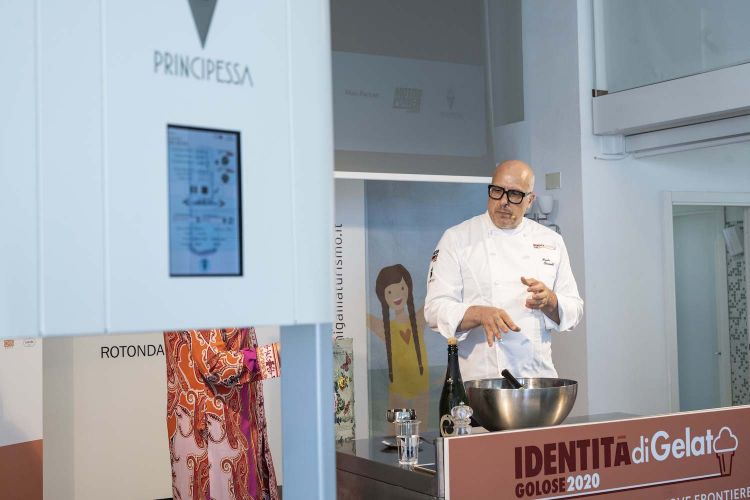
Paolo Brunelli at Identità di Gelato
– On stage with
Gabriele Tangari, an old acquaintance of
Identità Golose – he used to be
Identità Golose Milano’s pastry chef – here’s
Paolo Brunelli, “gelato maker, chocolate maker, a handler of sweet things”, that’s how he defines himself. He’s the third and last local prophet, after chefs
Cedroni and
Uliassi: «I arrived here in Senigallia in 2015. One morning
Paolo Marchi came to visit. I was wearing a jacket with the signature of eight colleagues who had been at my place for the opening. He took a picture and at first I didn’t get why. I did later: the importance of sharing, of working as a team. Senigallia has become a culinary destination thanks to
Moreno,
Mauro… And I have made my small contribution too». A few days ago, a new step, with the opening of
Paolo Brunelli Combo, his second establishment, in Marzocca, little over 1 km from
Madonnina del Pescatore: «I’d like it to become a further step for contemporary gelato, looking at the future, and capable of being offered throughout the year. An ice cream worth discussing and tasting, like a great dish. Without changing identity, as everyone must be able to enjoy it»; if anything, it can become “strange” by adding other products, «or perhaps with a special pairing».
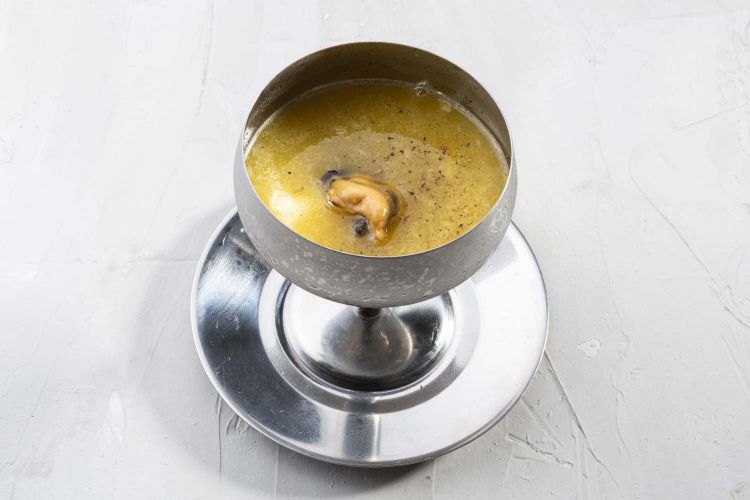
Brunelli’s "sgroppino" with wild mosciolo from Portonovo
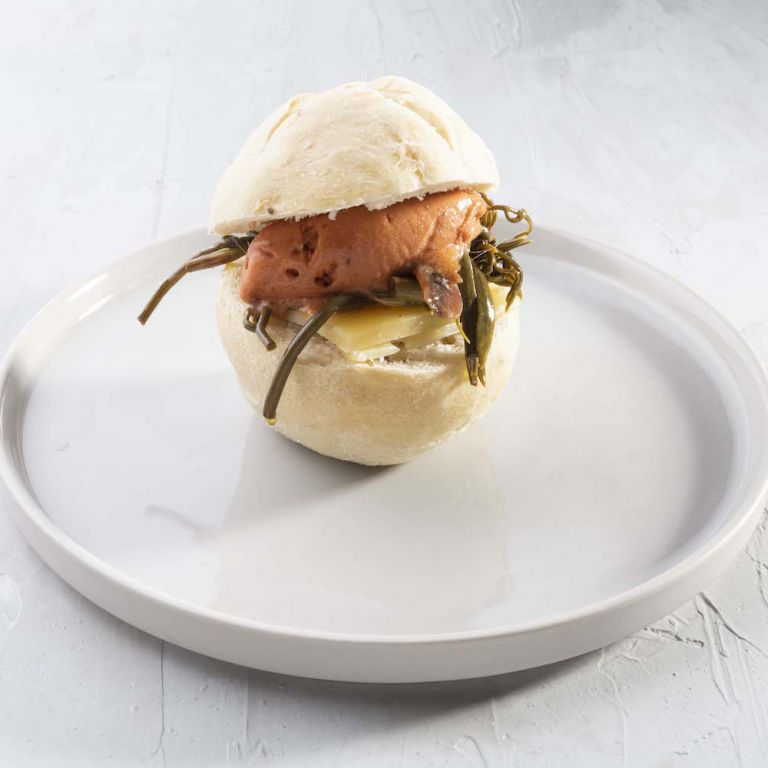
His first recipe on stage is inspired by memories («They’re crucial») and gives value to the wild mosciolo from Portonovo, a Slow Food presidium from the Marche. Recalling the oyster-Champagne pairing, here comes the mosciolo-Verdicchio one; Brunelli agrees that the name may not sound as great but it’s great on the palate: it’s basically a sorbet of Verdicchio and late mandarins from Ciaculli, with some brown sugar, a sort of sgroppino with a mosciolo. But the forte is another, and it’s connected with the Comboproject. A premise: «The weak point of gelato is that you eat it mostly in the summer, and rarely during a meal». Here is instead a gourmet panino gelato (Brunelli has already made others: panino with mortadella and pistachio sorbet, panino with robiola from Roccaverano and hazelnut gelato…): this has paccasassi, which are seaside greens typical of Conero, similar to salicornia; and then anchovies, Sichuan pepper, Dutch cheese and a sorbet made with Inspiration Valrhona raspberry chocolate (20%) and grilled peppers. All this in a special roll, with no salt. The tasting: super delicious. Brunellisays: «The difference between a contemporary ice cream maker and an old style one is the following: the modern one must first think like a mathematician, and then forget the numbers and think like a chef».
Without forgetting the past and the old (gelato) flavours. So Brunelli off stage prepares a malaga flavoured gelato, the kind you very rarely find these days, like cassata, amaretto, spagnola, torroncino… You’ll want more and more.
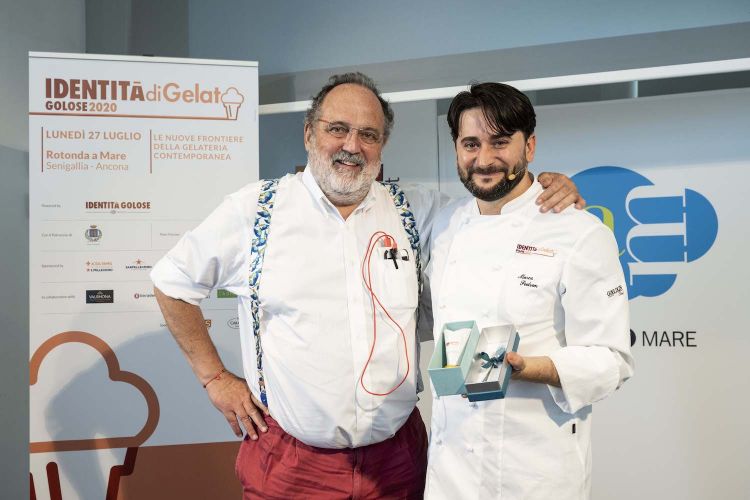
Marco Pedron with Paolo Marchi
MARCO PEDRON – Born in Milan in 1981, Marco Pedron is neither a chef nor an ice cream maker, like the speakers before him. He’s a pastry chef, but not an ordinary one. He’s Carlo Cracco’s pastry chef. In other words, he rules over the 130 sqm laboratory overlooking Galleria Vittorio Emanuele which supplies the bread for the gourmet restaurant and the cakes for the bistro, forCarlo e Camilla, as well as all the other leavened products. These past few months have been very intense for him, «during the lockdown our online platform exploded, plenty of orders». They’re working to second that success: «We’ll soon have a special area, a lab on the third floor only dedicated to leavened products».
For his recipe at Identità di Gelato, Pedron first of all guides us outside of Milan, to Santarcangelo di Romagna, where Carlo Cracco and Rosa Fanti, husband and wife, have bought a marvellous estate, from which they get fresh fruits, good oil and much more. The pastry chef says: «I found a variety of cherry there called Samba, very interesting. It’s a sort of delicacy from the late spring. We have pasteurised and frozen the pulp to be able to use it today too». How so? Alessandro Troccoli, maître at the restaurant, got the idea: a pizza. Seriously? Yes, a sweet pizza with a cherry sorbet instead of the tomato sauce.
Many will remember the polemics for “Cracco’s pizza”, we also wrote about it here:
Com'è la pizza di Cracco, secondo noi. «
Troccoli’s idea inspired me».
Pedron created a sort of stracciatella which is in fact a semi-whisked cream, with pieces of mascarpone «that stay on top as if they were mozzarella». He made some changes to the pizza dough, using
Petra 5; he vetrified it, that is to say he cooked it on both sides so as to get a crispy caramelization. On top, the fake stracciatella, the cherry sorbet (left partly in pieces, partly micronized and aromatised with drops of barolo chinato, umeboshi vinegar, cherry vinegar and Albana di Romagna), as well as leaves of
calypse, a Brazilian plant, «similar to sour cherries». Finally, powdered cherries, sorrel and pistachio. «I’m a pastry-maker who lives inside a kitchen, so I receive many influences. I keep getting ideas that overlap with other ideas».
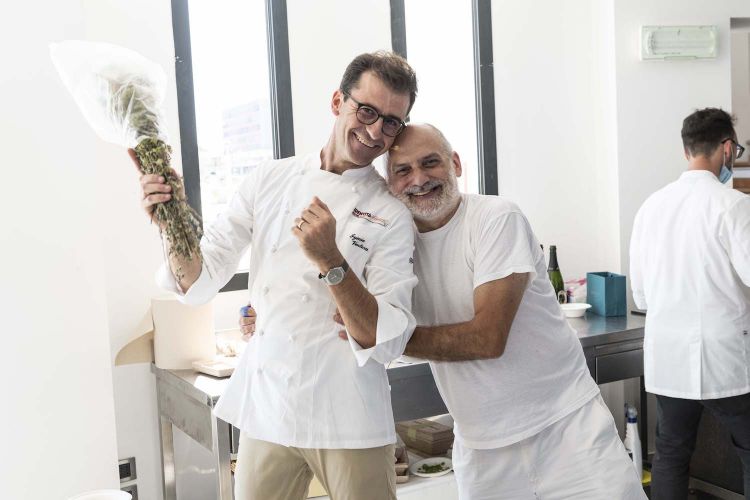
Iginio Ventura, left, with Corrado Assenza
– From cherry to black cherry, with
Iginio Ventura, who used to be a jeweller in Peschici but then inherited the ice cream shop from his grandmother and fell in love with it, rediscovering the varieties and fruit flavours of his area, often forgotten. He says: «I want to rediscover the flavours of the past, which once had no value. They were food for the poor, and were abandoned because of standardisation. Today, instead, they’re extraordinary treats, outside of the large distribution chains, and very hard to find». Like black cherries, «which are not typical of my area» and in fact are rarely presented alone in ice cream shops. But he does, and the result is extraordinary, adding crumbled amaretto from
Rocco Monaco from Vico del Gargano and the natural aromas of his region, like rosemary, wild mint, oregano and thyme. «I decided to present something very simple, but essential, it goes straight to the heart of the flavour. I want to be as faithful as I can to the original». Simple doesn’t mean banal, «it’s a rollercoaster of flavours, first you notice the sweetness, then the bitterness, and then again the sweetness …».
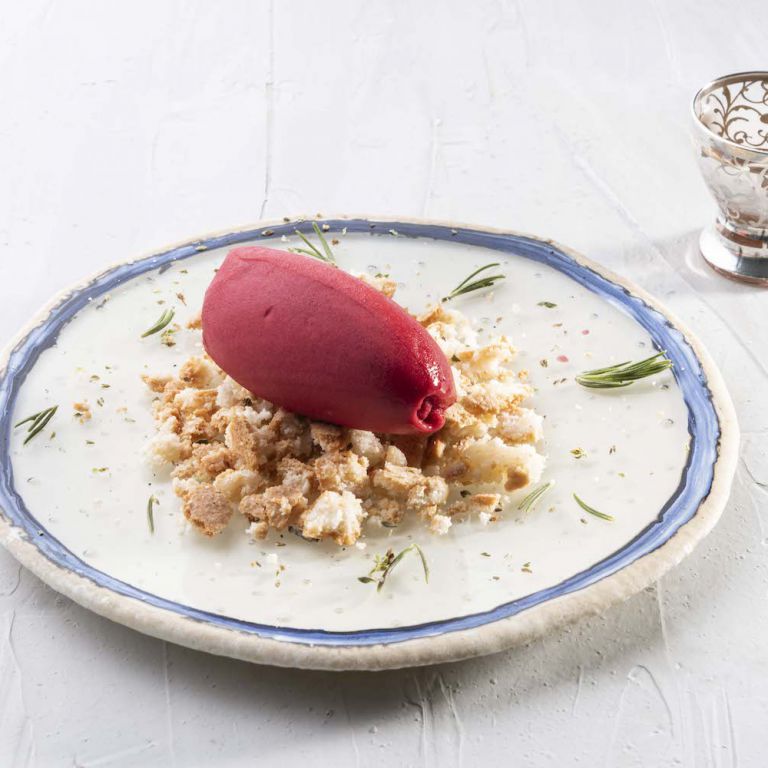
Black cherry sorbet from Ventura
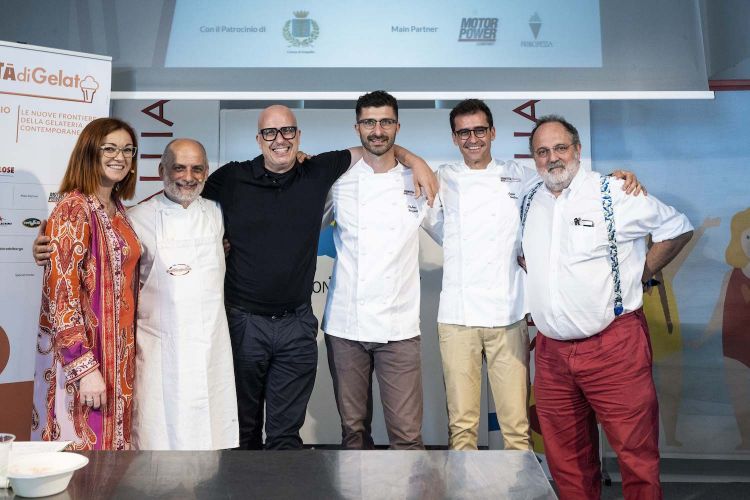
Ventura, second from the right, with, left to right Cozzella, Assenza, Brunelli, Guizzetti, Marchi
And there’s also a secret that makes this sorbet fantastic. It comes from a cold extraction of black cherries, partly with the stone, partly without, as if it were an
armellina, it gives charming, sinuous notes, «so you can sense everything: the wood, the seed, the juice, the pulp». Another special aspect: ice creams are usually better the sooner they are eaten; in this case it is ideal to make them rest overnight, «it’s one of those flavours that need some waiting so that they can fully express themselves».
Ventura‘s
Pinagel is currently closed because of renovations, but he sells eight flavours with his Ape Car. Too few? When the shop will open again, hopefully in mid-August, they won’t be more than 16, «because quality wins over quantity. And then you must train clients to choose well».
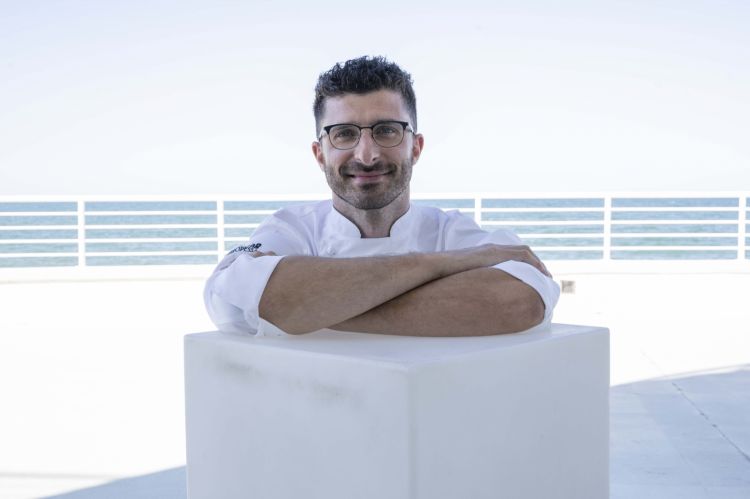
Stefano Guizzetti and the sea in Senigallia
STEFANO GUIZZETTI – Born in Bergamo in 1982, Stefano Guizzetti (from the Ciacco ice cream shops in Parma and Milan) is sort of the opposite of Ventura, though they share the same result, that is to say a purity of flavours. After all, he studied agricultural studies with a dissertation on the chemistry of gelato… So he aims to create flavours that will make you go back to situations, places; to put it in his words, «I want to tease the experiential memories of the scents of something not edible, but still part of our lives». Such as? «For instance, I’m studying a gelato that evokes the scent of the air before a storm».
Work in progress, that is. In the meantime, he presents three tastings plus one. The initial trio has the following flavours: hay, fig leaves, underwood. He says: «Playing with aromas and ice creams is not easy, because usually it’s the heat that enhances the aromas». But he works hard, «one of the first ice creams I made, many years ago, was a sorbet of uva fragola. It immediately reminded me of my grandparents’ house. Since then, I focus on memories». The hay gelato, like the other ones based on milk («Because fats act as a conductor of aromas») derives from a cold extraction of alfalfa, «I wanted to present the area where I live, the hills of Parma, with their scent of forage». Second tasting: fig leaf gelato, «I’ll take you to a summer’s night, underneath a nice plant of figs». Third, underwood, which he recreates with an infusion of fir bark, «picked when there’s more lymph, from larger trees, so richer in aromas. The result is an earthy, humid aroma».
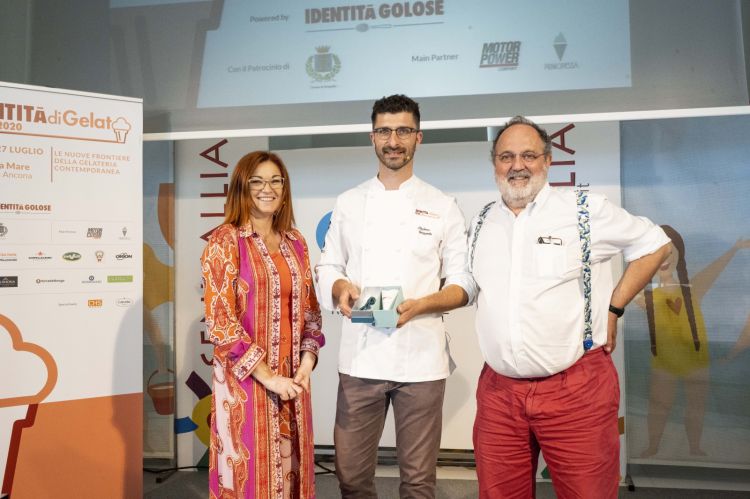
Cozzella, Guizzetti, Marchi
Everything very interesting. But the real fireworks arrived at the end: oaked gelato. In the sense that the base of the gelato is made with milk “matured” for one week at 65°C in toasted new oak barrels, «the heat acts as a catalyser of aromas». It’s a masterpiece: you can sense rum, vanilla, coffee, liquorice, caramel... Not just an exceptional idea, but also the demonstration of how fertile
Guizzetti’s research is.
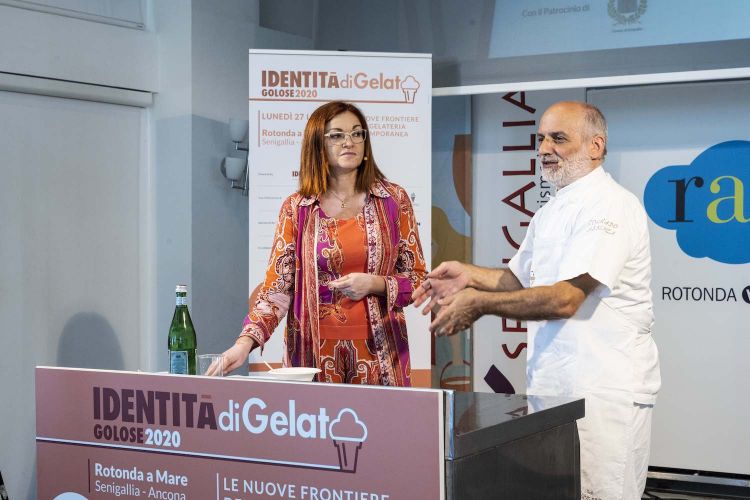
Corrado Assenza on the stage
CORRADO ASSENZA – Grand finale with Corrado Assenza. Eleonora Cozzella, who duetted with the seven speakers throughout the day with her usual brightness and competence reminded him of a famous quote of his: «There’s no such thing as a savoury chef and a pastry chef as opposites, because nature itself is neither sweet or sapid: these are categories we apply as humans, in a totally arbitrary way, to food». He confirms these are his words but adds: «Professionals – and not only them – are capable of fully using their senses to show a sensitivity towards what surrounds them and which exists regardless of us. In other words: we’re at the same time a thermometer of nature, and we’re nature too. Hence for a chef salt and sugar are not opposites, and the same goes for a pastry chef; these are connected dimensions. If there was a contrast, instead, it would almost imply a lobotomy of our capacity of analysing nature, drawing the best of (and from) it, and bringing it into our pantry».
This is the concept behind a “historic” dish that Assenza presented at Identità Golose 2006, charming the participants with his Almond granita with oysters and chilli pepper. «At the time – Paolo Marchi later pointed out – we didn’t fully realise how important it would become to redefine the universe of cones and cups, of flavours and textures within restaurants. Since then, the research on gelatos has never stopped».
The great
Corrado starts from that famous granita, which is served in Senigallia as a tribute to a moment when the walls between ice cream shops and fine dining were broken. «This recipe -
Assenza explains – was and is still linked to the sweetness hidden in the marine sapidity of oysters, which taste like watermelon» and is perfectly paired with another sweetness, that of the granita made with romana almonds from Noto, which have a bitter note and a high percentage of fat, 60%. «This makes this almond perfect for pairings» with seemingly different nuances of flavour, such as oysters (plus there’s the spiciness of the chilli pepper, «which enhances the shared sweet-savoury notes»).
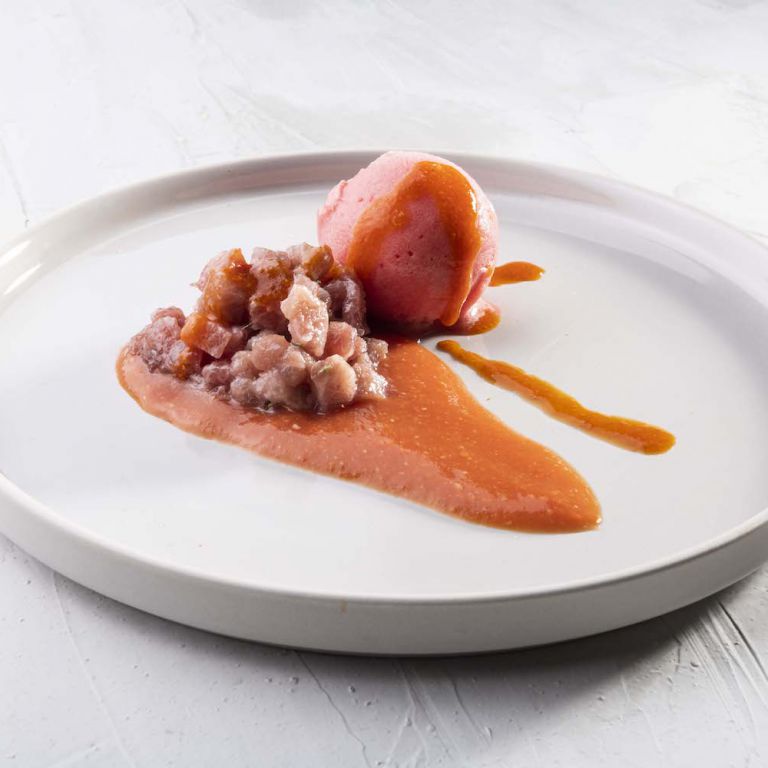
Black cherry sorbet, emulsion of grilled peppers, sea urchins, red tuna tarantello, sauce of grilled tomatoes
evokes another lesson he gave at
Identità Golose, the one on the iconic meat gelatos («They still await for someone to interpret them, so I’ll do it myself») before illustrating his new recipe:
Black cherry sorbet, emulsion of grilled peppers, sea urchins, red tuna tarantello, sauce of grilled tomatoes. He explains: «Tomato, pepper and black cherries are not particularly good together. But they all go very well with tuna, and show different types of sweetness», hence they can go together. In the tomato sauce
Assenza uses the entire fruit; the emulsion is made of 30% pulp of the pepper and 70% with the water it released when grilling, plus the sea urchin. And the black cherry? «It’s difficult, they are hard to find, and no longer in Noto but on Etna. I get them from
Sebastiano Scandura. If I blended them, they would lose intensity in terms of flavour and colour. So I make them current with an ancient process: I put them in a ventilated oven at 110°C with 50% humidity for 6 or 7 minutes. It’s the same amount of heat it received in the glass jars my mother used to leave in the sun, something she learnt from her own mum». It’s the contemporary emulation of an ancient process no longer allowed by current laws; that is to say a perfect example of
retro-innovation.
PRINCIPESSA – Identità di Gelato was created and organised by Identità Golose in partnership with Motor Power Company, the company from Castelnovo di Sotto (Reggio Emilia) specialised in industrial and robotic automation. What has that got to do with gelato? Managing director Christian Grandi explained: «It all comes from our curiosity: we wondered how our technologies could help ice cream makers. We were looking for innovative answers that could be applied to a seemingly distant world». The result was Principessa, an ice cream machine «that replicates the work of an artisan but with an automatised process, flexible and environmentally friendly. That is to say: the art of gelato with contemporary technology».
We will return on this. After all, as the vice mayor of Senigallia, Maurizio Memè, pointed out «this was the first edition of Identità di Gelato. But we have already planned to host at least three more here».
Translated into English by Slawka G. Scarso